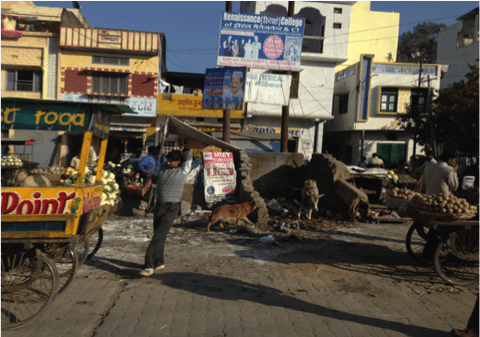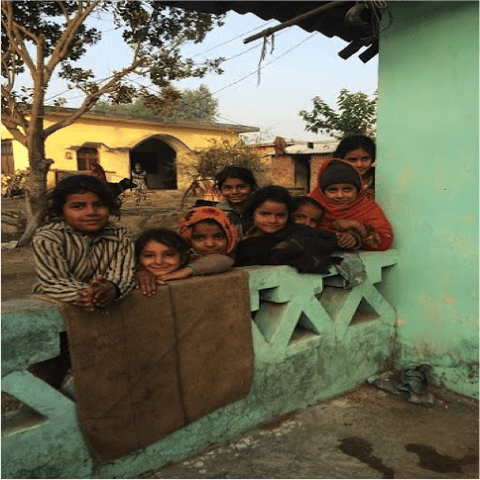My Glimpse at Different Conservation Solutions in India
March 4, 2015
By: Rebecca Lamphear
As I arrived at the airport and prepared to meet my classmates from the Online Master of Natural Resources program in person for the very first time, I began to feel a bit apprehensive at the task before us. Our goal: an analysis of the sustainable livelihood programs in the Western Terai-Arc Tiger Conservation landscape, State of Uttarakhand, India. I wasn’t sure what to expect from this ten-day International Field Experience but several questions crossed my mind right off the bat. How can we reasonably address sustainable livelihoods within urban and rural regions suffering from extreme poverty? How is tiger conservation viewed within India? And is it possible to preserve this top predator? But there was little time to dwell on the immensity of the task as we began our very busy trip throughout the tiger conservation landscape.

As our group traveled from the airport to our initial location within the New Delhi city limits, the view from our vehicles seemed chaotic. There were men on elephants traveling to a cultural ceremony; street beggars dressed in many layers of clothing knocking on our car windows; a variety of brightly lit shopping stores selling clothes, groceries, and souvenirs; the India Gate archway; picnickers in flat grassy parks enjoying an afternoon lunch; a slum — all a part of the mid-day hustle and bustle of the city. This was the first of many hectic scenes we witnessed as we traveled throughout the northern landscape of India. A common theme resonated within me throughout the trip: chaotic but planned.
These varying settings provided us an opportunity to experience an interesting mix of complex challenges. This was my first time witnessing severe poverty, but it was immediately clear that the impacts of rapid urbanization affect the poor disproportionately. These populations are less resilient to catastrophic events such as job loss, natural disasters, or family deaths. There is a dire need for proper infrastructure, education, and health care within these communities. Another common issue in the area is human-wildlife conflict, which is a direct threat to source tiger populations as well as to safe living conditions for the villagers.
This posed several questions for our group. What are the constraints for the people existing within this landscape? Do they have access to health care and education? Are the governing laws protecting tigers allowing these villagers a means for sustainable employment?

The answers to these questions revealed mixed results. Tiger conservation was impacting livelihoods in both a positive and negative manner. New emerging job opportunities, such as ecotourism, were available to people surrounding Rajaji and Corbett National Parks, yet clearly there were some people left without significant means or skills for gainful employment. In order to preserve tiger populations, many villagers were removed from their historical pastoralist lifestyle, which were now in core protected areas, and moved to new locations. These villagers were forced into a completely new way of life, with different job options, such as park ranger or owner of a tourist shop, each requiring new skill sets.
We met a multitude of stakeholders engaged and working tirelessly towards the goals of sustainable livelihoods and biodiversity conservation. These groups and many other alternative collaborations between stakeholders — both governmental and non-governmental organizations — are preserving livelihoods and linking fragmented tiger habitat through this region. One example is the relationship between the Indian Forest Service and the Corbett Foundation. Both work in conjunction with villagers to improve the interim relief scheme (IRS), which provides monetary assistance to villagers that lose cattle, or who have themselves been killed or injured by wildlife.
Self Help Groups (SHG) were also established to improve livelihoods within many local communities. These groups are organized and run by the individual community and funded by the government and other NGO’s. Significant work has occurred with SHG and women, particularly by training women to make crafts to be sold in local stores. In addition, the Corbett Foundation assists many villagers removed from protected areas by improving access to medical care. It has set up the Rural Medical Outreach Programme, a mobile clinic which visits almost 250 villages a year.

Our group witnessed another interesting approach to conservation and livelihoods within Rajaji National Park. In conjunction with the World Wildlife Fund, park rangers, who were originally relocated pastoralists, are helping to reduce the number of wildlife deaths along a railroad that bisects the park. They do so by monitoring the railroad tracks for wildlife then relay the information to the train conductors, giving them a chance to slow down for crossing wildlife.
Conservation within the Terai-Arc tiger conservation landscape still has a great many challenges, but what matters is that they have a large network of diverse people committed to solving these significant social and environmental challenges impacting the region. “There is no cookie cutter approach to conservation,” stated professor Dr. Jennifer Sevin while in India. This proved to be a defining point during our IFE trip. I realized how crucial it is to incorporate the component of culture into any conservation tool, because the human dimension is key to understanding and implementing effective long-term global sustainability solutions.
Prior to our trip I felt I had a rather well-rounded understanding of the constraints impacting conservation and livelihoods in India. However what I did not realize were the diverse methods being used to achieve these much desired sustainability goals. Perhaps many of the methods are not typical tools used in the United States, but it works within the Indian culture with its rich history of and close relationship with nature. I realized conservation management in India is different, but that’s OK. Different is OK.
My graduate education thus far has provided me with an opportunity to investigate how and why our natural resources are being used in the twenty-first century. In particular the future impacts of unsustainable resource uses on the livelihoods of the 1.4 million living below the international poverty line. This knowledge will translate into my professional career as an urban forester where I will be making decisions on managing future natural resources. Fostering social capital between a diverse set of individuals or groups can lead to great solutions, which not only benefit the community but the surrounding landscape.
The online courses and International Field Experience have provided me with opportunities to learn and view the day-to-day challenges of emerging economies, as well as the variety of solutions to some of the world’s most challenging issues. It’s clear that the ways in which we engage stakeholders must take into account those below the poverty line, and what I saw in India makes me hopeful for our future.


